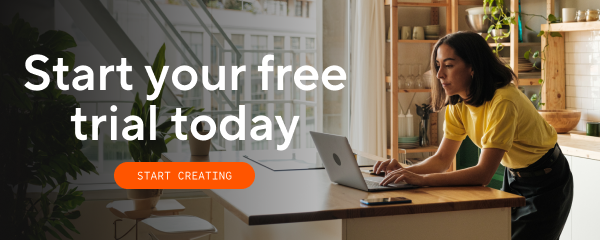What You'll Learn in This Guide
- How to write blog posts that serve dual purposes, educating and converting
- Technical best practices for WordPress blogging
- Image optimization strategies for better engagement
- SEO techniques that feel natural, not forced
- How to repurpose Instagram content for your blog
- A complete framework for consistent blog success
- Why Showit is the best platform to write and host your blog.
Why Your Blog Posts Matter More Than Ever for Your Creative Business
Your website isn't just a portfolio, it's your hardest-working team member. And your blog? That's where the magic happens. It's where you connect with potential clients, showcase your expertise, and yes, climb those search rankings.
We're sharing our exact framework for writing blog posts that do double duty: they genuinely help your readers while naturally guiding them toward becoming part of your community (and maybe even Showit users like you!).
The Two-Part Mission: Connect and Convert
Every great blog post serves two purposes:
- Elevate and educate your readers — Give them real value, answer their questions, and help them succeed in their creative business
- Convert readers into action-takers — Whether that's booking your services, joining your email list, or trying Showit for their own website design needs
Think of it this way — when you help someone solve a problem, they remember you. When they need a bigger solution (like professional photography, design services, or a website platform), you're already their trusted resource.
Who This Guide Is For
This blogging framework works especially well for:
- Photographers building their brand through storytelling
- Web designers sharing their expertise and attracting clients
- Creative entrepreneurs establishing thought leadership
- Small business owners who need their website to work harder
- Content creators looking to expand beyond social media
- Service providers wanting to showcase their expertise
Whether you're DIY-ing your website or working with a designer, these strategies will help your blog become a powerful business tool.

Writing Blog Posts in WordPress: Your Technical Playbook
Getting Your Content Looking Professional
Here's the thing about WordPress: what you see in the editor should match what your readers see on your website. No surprises, no formatting weirdness. Just clean, professional content that represents your brand beautifully.
Image Requirements That Make a Difference:
- Minimum width: 280px (but we recommend at least 700px for crisp, professional display)
- Always verify image permissions; grabbing from Google Images isn't just risky, it could hurt your creative business
- Pro tip: Use your own photography when possible, it showcases your work AND keeps you legally protected
Writing for Long-Term Value
Want your blog posts working for you months (even years) from now? Here's how:
- Skip date-specific references — Instead of “this year,” use evergreen language that stays relevant
- Create timeless resources — Focus on principles and strategies rather than fleeting trends
- Update strategically — Refresh statistics and examples annually without rewriting everything
SEO Keywords That Feel Natural
These power words strengthen your search rankings when woven naturally into your content:
- Website and web design
- Photography and photographer
- Creative professional
- Design and designer
- Small business
- Creative entrepreneur
Remember, forced keywords feel awkward. Use them where they make sense, like when you're genuinely talking about website design for photographers or tools for creative professionals.
Featured Images That Stop the Scroll
Your featured image is your first impression — make it count! Here's what works:
The Perfect Featured Image Checklist:
- No text overlays — Let the image speak for itself
- Center your subject vertically — Images get cropped top and bottom, so keep important elements in the middle
- Go wide — Landscape orientation (horizontal) works better than portrait (vertical)
- Think big — Minimum 1500px width for crystal-clear display
- Choose wide-angle shots — They create more visual interest and flexibility
Quick Audit for Existing Content
Take a Saturday morning to review your older posts. Either remove dated featured images or swap them with fresh photos that align with your current brand aesthetic. Your website's cohesion matters!

Common Blogging Mistakes to Avoid
Even experienced creators make these mistakes; here are a few to avoid:
1. Writing for Everyone Instead of Someone
The Mistake: Trying to appeal to everyone
The Fix: Picture your ideal reader and write directly to them
2. Ignoring Mobile Readers
The Mistake: Only checking how posts look on desktop
The Fix: Always preview on mobile, that's where most readers are
3. Forgetting the Call to Action
The Mistake: Ending posts without clear next steps.
The Fix: Every post should guide readers somewhere — your services, email list, or another helpful resource
4. Inconsistent Publishing
The Mistake: Posting sporadically when inspiration strikes.
The Fix: Even one quality post per month beats random bursts
5. Skipping the Proofread
The Mistake: Publishing immediately after writing.
The Fix: Step away, then return with fresh eyes (or use a tool like Grammarly)
Turning Your YouTube Videos into SEO-Powerful Blog Posts
Your YouTube content is already working hard, but it could be working even harder. Video content transformed into blog posts can triple your reach, boost your SEO, and serve the 65% of people who prefer reading to watching. Here's how to make that magic happen:
Why Video-to-Blog Conversion Works
- SEO Double-Dip — Google can't watch your videos, but it loves reading your blog posts
- Reach Different Learners — Some folks want to watch, others need to read
- Create Scannable Resources — Viewers can quickly find that one tip they remembered
- Build Authority — Written content positions you as an expert in search results
The YouTube-to-Blog Transformation Process
Step 1: Start with Your Video Transcript
Don't just copy-paste your transcript; that's where most creators go wrong. Instead, use a tool like Kame.Ai's YouTube transcript generator to get a high-quality transcript
Step 2: Restructure for Readers (Not Viewers)
Video says: “Hey guys, welcome back to my channel! Today we're talking about…”
Blog says: A clear headline and immediate value proposition
Video says: “As you can see on screen here…”
Blog says: Embedded screenshots, graphics, or the actual video at relevant points
Video says: “Remember to like and subscribe!”
Blog says: “Get weekly tips delivered to your inbox” with an email signup
Step 3: Enhance with Blog-Only Value
- Add downloadable resources — Checklists, templates, or guides mentioned in the video
- Include detailed screenshots — Show what you're explaining
- Create summary boxes — Quick-reference sections for key points
- Expand on complex topics — Add context that would slow down a video
- Link to related content — Build your content web.
Repurposing content is one of the most important things to master and understand for your business.
Orbit Media's Blogging Statistics Study found that bloggers who repurpose content are 2.5x more likely to report strong results, and posts over 3,000 words get 3x more traffic and 4x more shares” (easier to achieve when expanding video content)
Additionally, Search Engine Journal found that 65% of people are visual learners, but 35% prefer reading – you're missing over a third of your audience with video-only content.
The important thing to understand is to have content available on all types of platforms across the web.
Your Blog Post Success Framework
Ready to put this all together? Here's your action plan:
- Start with your reader's needs — What problem are they trying to solve?
- Structure for scannability — Use headers, bullets, and short paragraphs
- Include visuals that enhance — Screenshots, examples, or your own photography
- End with a clear next step — What should readers do with this information?
- Optimize technically — Check your images, SEO keywords, and mobile display
You have the framework, now give your blog the perfect home. When you blog on Showit, you design every detail of your blog’s layout and style in the design app, while WordPress handles your content editing and SEO. It’s the best of both worlds in one subscription. Start your free trial to get started.
Frequently Asked Questions
How often should I publish blog posts?
Consistency beats frequency. Whether it's weekly, bi-weekly, or monthly, pick a schedule you can maintain. Your readers (and search engines) value reliability.
What's the ideal blog post length?
Aim for at least 1,000 words for SEO value, but let the topic guide you. Some topics need 500 words, others need 2,000. Quality and completeness matter more than hitting a specific number.
Should I allow comments on my blog?
Comments can build community but require moderation. If you're just starting, focus on creating great content first. You can always add comments later.
How do I know what topics to write about?
Listen to your clients' questions, check what your competitors are writing about, and use tools like Answer the Public to find what people are searching for in your niche.
Can I republish content from other platforms?
Yes, but use canonical tags to avoid duplicate content penalties. Better yet, expand and update the content to make it unique for your blog.
Blog Post Templates to Get You Started
The How-To Post
Structure: Problem → Solution → Step-by-Step Process → Results<br> Example: “How to Prepare for Your Brand Photoshoot”
The List Post
Structure: Introduction → Numbered/Bulleted List → Conclusion<br> Example: “7 Website Mistakes That Cost You Clients”
The Case Study
Structure: Client Challenge → Your Process → Results → Takeaways<br> Example: “How We Helped Sarah Triple Her Inquiries”
The Behind-the-Scenes
Structure: Setup → Process → Challenges → Final Result<br> Example: “Creating Our Studio's New Look”
The Resource Round-Up
Structure: Introduction → Categorized Resources → How to Use Them<br> Example: “Our Favorite Tools for Creative Entrepreneurs
Keep Creating, You've Got This!
Your blog is more than just words on a page — it's how you build trust, showcase expertise, and grow your creative business. Every post is an opportunity to connect with someone who needs exactly what you offer.
Remember, the best blog post is the one you actually publish. Start with these guidelines, but don't let perfection stop you from sharing your unique perspective with the world.
Ready to build a website that showcases your blog beautifully? Showit's drag-and-drop design tools make it easy to create a blog that looks as good as your content reads. Start your free trial and see the difference a well-designed website makes for your creative business

